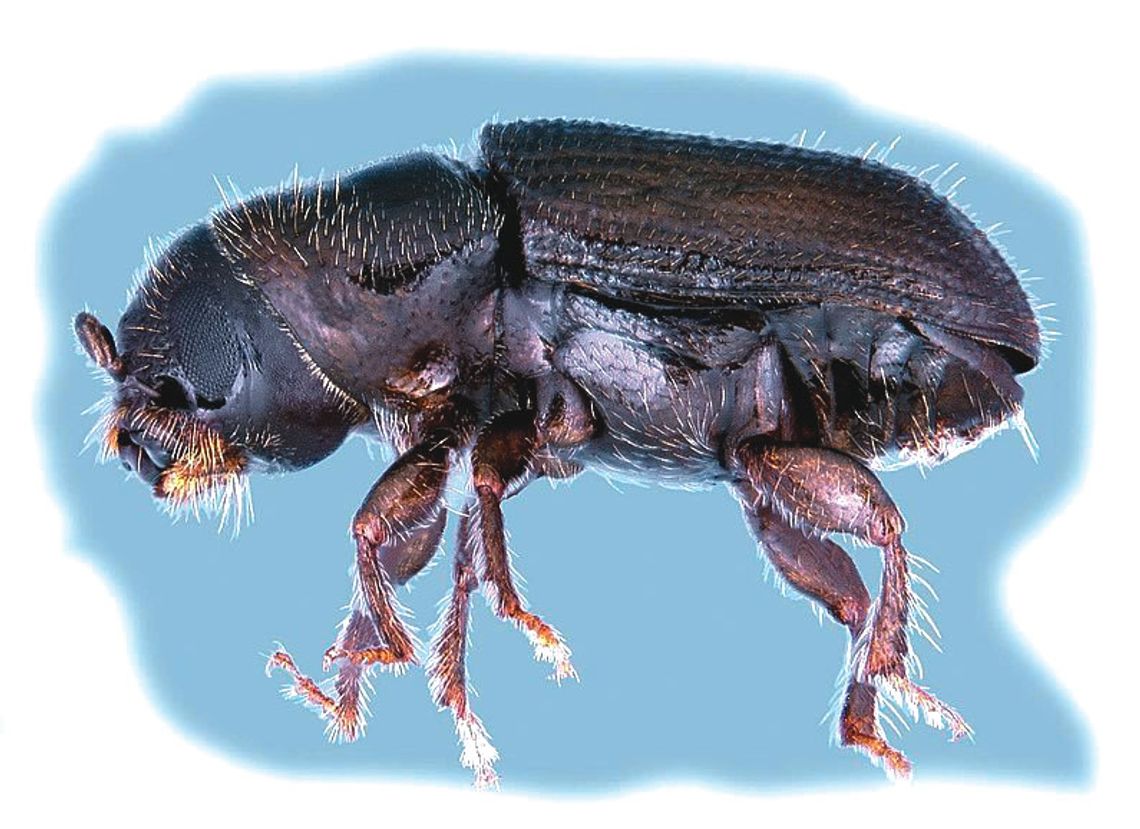By Doug Carter, Rankin County Extension Agent
We are beginning to see pine beetle activity in pine trees in Rankin County this fall. The scientific name for the southern pine beetle (SPB) is Dendroctonus Frontalis Zimm, which means “tree killer." The SPB has been just that in Mississippi pine stands for hundreds, if not thousands, of years. Many landowners have suffered losses, ranging from a few hundred trees to entire stands. At low population levels, SPB still attacks stressed, damaged or overly stocked stands. However, at high populations, SPB will attack mass numbers of trees, killing them regardless of age, size, or conditions.
Inadequate monitoring and failure to control known infestations can result in loss of valuable stands of pine timber. Producers will lose money when they have to clear cut prematurely or harvest stands during poor market conditions to avoid an expected loss to the SPB. With proper monitoring and control efforts, losses should be less than 10 percent of the stand over the course of an epidemic period. It is important to recognize the SPB, to know what control tactics are available, and to make an informed decision concerning this pest if you were to have an infestation on your property.
The first indication of an attack is usually yellowing or browning of needles. The trunk will usually reveal white, yellow or sometimes red-brown pitch tubes, about as large as a wad of gum, and from a distance may look like popcorn. Under drought conditions, these pitch tubes may be very small or absent, and only reddish-brown boring dust will be present. Removal of the bark will show a distinctive winding “S” shaped gallery pattern. This pattern is quite different from the “Y” or “H” shaped gallery patterns of the Ips Beetle and is a good identification characteristic. Anytime the temperature increases above 55 degrees F, they continue to develop or even move to new trees to continue the infestation.
In a forest situation, there are several control techniques available for SPB infestations:
- Salvage removal: many times, the trees involved in the infestation can be sold. Even if it is sold as just pulpwood, the logging operation just breaks even. The pine beetles are removed from the property with the trees.
- Cut and leave: this technique is the same as salvage removal, except that the trees are not removed from the area. It is important to fell the trees toward the middle of the infestation. However, we need to avoid a large pile of wood that shades the infested bark. Direct sunlight can increase the temperature enough to kill the beetles. The technique is the least expensive of the three methods. Since higher temperatures play a high role in the success of this tactic, it is restricted to the summer months when temperatures average above 85 degrees F.
- Pile and burn: this is probably the oldest of the control tactics. It is very effective when properly used, but the labor required to cut, stack and burn the infested trees can be expensive.
On a landscape setting, Onyx can be used. Onyx is a chemical used for pine beetle prevention. It is available, but it is available only for ornamental pines. Onyx is applied on the outside bark of the tree, and it kills beetles on contact for 4 to 6 months. Onyx will not stop beetles from killing an already heavily infested tree. It is best used on uninfested trees next to others that are infested.

Ips Beetles
The Ips beetle is a common beetle of landscape pines. Attacks are normally focused on the trunk and large limbs located in the upper or crown area of a tree. Pitch tubes and red boring dust can be found in bark crevices in trees under attack from Ips beetles. Adult Ips Beetles bore through the outer bark and excavate galleries in the inner bark, or cambium layer. The larvae construct their own feeding galleries. When the larvae mature and emerge from the tree as adult beetles, they leave numerous small, round emergence holes that cause the bark to look as though it has been shot with birdshot.
Keep trees well watered during dry periods. Avoid injury or stress on trees. Trees that have been physically injured are more likely to be attacked. Once a tree gets stressed, it is less able to defend itself. Avoid situations that cause soil compaction, root injury or drought. Remove dead or dying trees as soon as possible, to prevent beetles from moving to healthy trees. Because Ips beetle attacks are concentrated in the crown area, preventive insecticide treatments are very difficult to use effectively.
Black Turpentine Beetles
Black Turpentine Beetles are one-fourth to one-third inch long, barrel-shaped, and reddish brown to black in color. They bore holes through the outer bark of pine trees and lay their eggs in the cambium layer. Popcorn-sized masses of dried resin, which are called pitch tubes, often mark the spot to show where the tree is under attack. These pitch tubes usually contain reddish-brown boring dust. Attacks by black turpentine beetles are usually on the lower 6 to 10 feet of the trunk. As with other beetles trees suffering injury or stress are most susceptible to attack.
One of the best defenses against black turpentine beetles, is to keep trees well-watered during drought periods. Another control method to use when infestations of black turpentine beetles are evident on nearby trees is to use sprays containing a permethrin. Several brands are labeled for homeowners. Be sure to use a permethrin that lists use of pine trees to control borers. Homeowners may need to repeat sprays several times during the summer for adequate protection.
Sources: Mississippi State Extension Publication 2748, Southern Pine Beetle in Mississippi: An Overview.


Comment
Comments